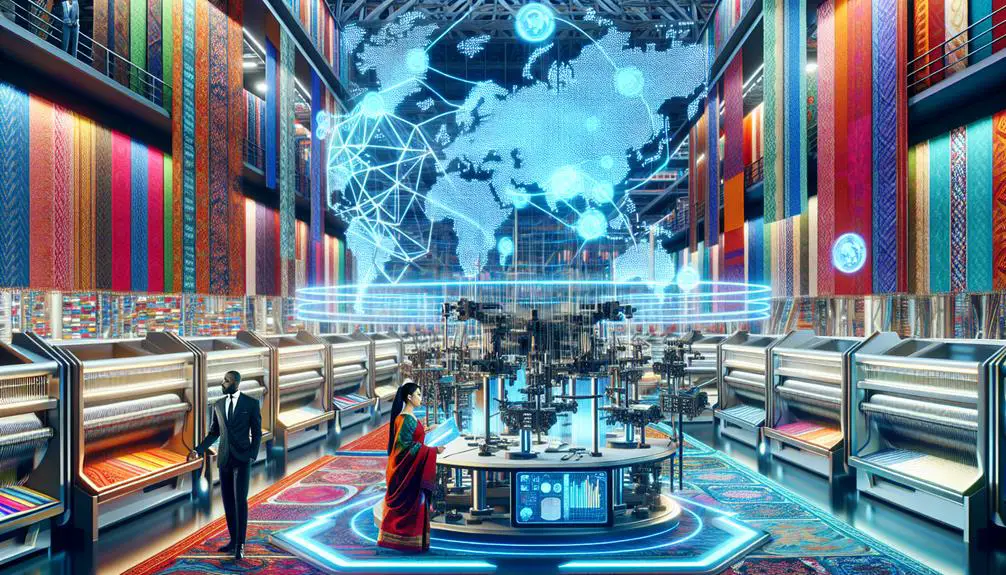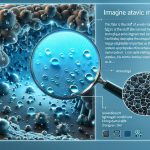Just like Da Vinci's foresight in the Renaissance, you're about to witness a transformation in the global fabric market that combines art and science. The rise of smart textiles and sustainable materials isn't just a trend; it's a necessity driven by eco-conscious consumers and technological advancements. The market's future hinges on innovations like fabric sensors and nanotechnology, promising breakthroughs in health monitoring and energy efficiency. You might wonder how these shifts will impact supply chains and regulatory frameworks, and that's where the real intrigue begins.
Table of Contents
Key Takeaways
- Fabric innovations include smart textiles for health monitoring, energy harvesting, and temperature regulation.
- Sustainable materials like recycled polyester, organic cotton, and biodegradable fabrics are increasingly prioritized.
- Advancements in nanotechnology are producing lightweight, strong, and self-cleaning fabrics.
- Consumer preference is shifting towards eco-friendly, ethically produced textiles with non-toxic dyes.
- Digital transformation and global sourcing are revolutionizing the supply chain and production efficiency.
Technological Advancements
With rapid technological advancements, the global fabric market is transforming at an unprecedented pace. You're witnessing a revolution driven by fabric sensors and data analytics, which are reshaping how textiles are designed, produced, and utilized. Fabric sensors embedded in textiles can now monitor various parameters such as temperature, pressure, and even biochemical changes. These sensors generate valuable data that's analyzed to enhance fabric performance, offering personalized and adaptive solutions for diverse applications like healthcare, sports, and fashion.
Nanotechnology is another groundbreaking development you can't bypass. By manipulating materials at the molecular level, this technology is creating performance fabrics with extraordinary properties. Imagine fabrics that aren't only lightweight but also exceptionally strong, water-resistant, and even self-cleaning. These advancements are pushing the boundaries of what fabrics can do, making them more functional and versatile than ever before.
As you explore further into these technological innovations, you'll realize their potential to revolutionize the fabric market. The integration of fabric sensors, data analytics, and nanotechnology is setting new standards, enabling the creation of high-performance fabrics that meet the evolving needs of consumers and industries alike.
Smart Textiles
You're about to see how smart textiles are revolutionizing the fabric market.
With wearable technology integration and advanced material innovations, these textiles are set to change how we interact with fabrics.
Let's explore the key drivers behind this market's impressive growth.
Wearable Technology Integration
Smart textiles are revolutionizing the fabric market by seamlessly integrating technology into everyday clothing. You're witnessing a transformative era where fashion trends and product development are increasingly driven by innovative fabrics that respond to your needs. These smart textiles can monitor your health, adjust to environmental conditions, and even power your devices.
Consider the following exciting developments:
- Health Monitoring: Embedded sensors that track your essential signs in real-time.
- Temperature Regulation: Fabrics that adapt to your body heat, ensuring comfort.
- Energy Harvesting: Materials that generate power from your movements.
- Interactive Displays: Clothes that can change hues or display messages.
As you explore deeper into wearable technology integration, you'll see how smart textiles aren't just about adding gadgets to clothing. It's about creating harmonious designs that enhance your lifestyle while keeping you at the forefront of fashion trends.
Product development in this field focuses on making these technologies more accessible, durable, and stylish. You'll find that the future of smart textiles isn't just a niche market but a growing segment poised to redefine how you think about clothing.
Embrace the innovation and stay ahead in this evolving landscape.
Advanced Material Innovations
Innovative materials are pushing the boundaries of what's possible in the fabric industry, offering smart textiles that redefine functionality and style. You can now explore fabrics enhanced through nanotechnology applications, which allow for unprecedented features like self-cleaning, water resistance, and enhanced durability.
Imagine a world where your clothing can adapt to environmental conditions or monitor your health metrics. Nanotechnology makes this not only possible but increasingly prevalent.
Bio based fibers are another groundbreaking development transforming the textile landscape. These eco-friendly materials, derived from renewable resources, offer sustainability without compromising on performance. Think about fabrics made from bamboo, organic cotton, or even bioengineered spider silk.
These materials provide the strength and elasticity needed for modern applications while being kind to the planet.
As you explore further into advanced material innovations, you'll see how smart textiles are becoming integral to industries beyond fashion, including healthcare, sports, and defense. These fabrics aren't just about looking good; they're about performing at a higher level and meeting the complex demands of today's world.
Embrace these advancements, and you'll be at the forefront of a fabric revolution that blends technology, sustainability, and unparalleled functionality.
Market Growth Drivers
Several key factors are driving the rapid growth of the smart textiles market, positioning it as a dynamic segment in the global fabric industry.
You're seeing an explosion of interest due to the integration of innovative solutions that enhance functionality and performance. These textiles are no longer just about aesthetics; they offer advanced features like temperature regulation, moisture management, and even health monitoring.
To keep you engaged, let's break down the primary drivers:
- Technological Advancements: Continuous innovations in materials and electronics are making smart textiles more effective and accessible.
- Consumer Demand: There's a growing appetite for multifunctional fabrics that offer more than just comfort and style.
- Healthcare Applications: Smart textiles are revolutionizing medical care with wearable health monitors and therapeutic garments.
- Global Expansion: The market is experiencing significant growth across various regions, fueled by increased investments and international collaborations.
Sustainable Materials
Embracing sustainable materials can greatly diminish the environmental impact of the global fabric market. By prioritizing eco-conscious initiatives, you contribute to a healthier planet and a more responsible industry.
One significant approach is the use of recyclable materials. These materials not only reduce waste but also lessen the necessity for virgin resources, which are often extracted through environmentally damaging processes.
You can explore fabrics made from recycled polyester or organic cotton, which use fewer chemicals and pesticides compared to traditional cotton. This not only minimizes water pollution but also promotes better soil health.
Additionally, innovations like biodegradable fabrics and low-impact dyes make sure that the end product has a minimal footprint.
Adopting these practices isn't just about compliance; it's about spearheading the movement toward a more sustainable future. By aligning your strategies with these eco-friendly initiatives, you're not just responding to market trends; you're setting the standard.
It's crucial to stay updated on advancements in sustainable materials and continually integrate them into your production processes. Doing so will strengthen your commitment to sustainability and position you as a forward-thinking leader in the fabric industry.
Consumer Preferences
As the fabric industry adopts more sustainable materials, consumer preferences are increasingly shifting towards eco-friendly and ethically produced textiles. You're not just looking for any fabric; you want textiles that align with your values and lifestyle. Consumers like you're prioritizing materials that offer both sustainability and high performance.
Key factors driving these preferences include:
- Color trends: You're drawn to colors that aren't only stylish but also produced using non-toxic dyes and sustainable practices.
- Eco-friendly options: You look for fabrics made from organic cotton, recycled materials, or plant-based fibers that reduce environmental impact.
- Customization options: You value the ability to personalize your fabrics, from unique patterns to specific textures, ensuring your choices reflect your individual taste.
- Material durability: You demand fabrics that aren't only sustainable but also long-lasting, minimizing the need for frequent replacements and reducing waste.
Market Innovations
You'll notice significant changes in the fabric market as sustainable fabric technologies gain traction.
Smart textile integration is also reshaping how fabrics function.
Additionally, advanced manufacturing techniques are streamlining production and enhancing quality.
Sustainable Fabric Technologies
Innovative sustainable fabric technologies are revolutionizing the global market by introducing eco-friendly alternatives to traditional textiles. By embracing these cutting-edge solutions, you're not just staying updated with the latest trends but also advocating for a circular economy.
Eco-friendly fabrics are crafted using processes that minimize waste and pollution, providing a sustainable choice for the conscious consumer.
Sustainable fashion isn't just a buzzword; it's a movement. Ethical sourcing guarantees that the materials used in these fabrics are acquired responsibly, supporting fair labor practices and reducing environmental impact. By incorporating these technologies into your products, you're aligning with a growing demand for transparency and responsibility in the fashion industry.
Here's what you should watch for:
- Recycled Materials: Fabrics made from recycled plastics or organic waste reduce the need for new materials.
- Biodegradable Textiles: These naturally decompose, leaving no harmful residues.
- Low-Impact Dyes: Natural and eco-friendly dyes that minimize water and chemical usage.
- Energy-Efficient Production: Techniques that decrease energy consumption and greenhouse gas emissions.
Smart Textile Integration
Building on the momentum of sustainable fabric technologies, smart textiles are setting new benchmarks in the global fabric market with their ability to integrate advanced functionalities into everyday clothing.
You're now witnessing how fabric connectivity and data integration are revolutionizing the way we interact with our garments. Imagine your workout clothes monitoring your heart rate or your business suit adjusting its temperature based on the climate—these are no longer futuristic fantasies but current realities.
Fashion tech is at the forefront of this transformation, blending aesthetics with functionality. Smart design isn't just about looking good; it's about performance and adaptability. Companies are embedding sensors and microprocessors into fabrics, allowing for seamless data integration. This means your clothes can communicate with other devices, providing real-time feedback and enhancing your daily life.
Advanced Manufacturing Techniques
Cutting-edge manufacturing techniques are redefining the global fabric market by enhancing production efficiency and material quality. You're now able to leverage innovations like 3D printing and nanotechnology integration to achieve unprecedented levels of precision and functionality in textiles. These advancements don't just promise higher productivity; they also open doors to entirely new applications and markets.
- 3D Printing:
You can create intricate fabric designs that were previously impossible with traditional methods. This technology allows for rapid prototyping and reduces waste significantly.
- Nanotechnology Integration:
By incorporating nanoparticles, you can enhance fabric properties such as water resistance, UV protection, and even antibacterial capabilities.
- Automation:
Implementing automated systems can streamline your production processes, reducing labor costs and improving consistency significantly.
- Sustainable Practices:
Advanced techniques enable more eco-friendly production methods, such as recycling waste materials and using less water and energy.
Supply Chain Dynamics
Supply chain dynamics in the global fabric market hinge on the efficient coordination between manufacturers, suppliers, and retailers. To master this coordination, you'll need to leverage digital transformation and global sourcing.
Embracing digital transformation allows you to streamline operations, enhance visibility, and make data-driven decisions. With real-time analytics, you can monitor inventory levels, predict demand, and manage logistics seamlessly, ensuring that your supply chain remains agile and responsive.
Global sourcing plays a critical role in diversifying your supply base, mitigating risks, and tapping into cost-effective manufacturing hubs. By sourcing materials from multiple regions, you spread out risk and enhance supply chain resilience. You can capitalize on regional strengths, such as specialized textiles from Asia or high-quality linens from Europe, to offer diverse and competitive products.
Integrating these strategies demands a keen understanding of market trends and technological advancements. Stay ahead by investing in robust supply chain management software and fostering strong relationships with reliable suppliers. By doing so, you not only optimize operational efficiency but also position your business to adapt swiftly to market changes, ensuring sustained growth and competitiveness in the global fabric market.
Regulatory Impacts
In today's global fabric market, regulatory impacts play a pivotal role in shaping industry practices and compliance requirements. You must navigate an intricate web of government regulations and industry standards to guarantee your business remains competitive and compliant.
These regulations are designed to promote sustainability, ethical labor practices, and consumer safety. Staying ahead of these rules can offer you a competitive edge.
Consider these key regulatory areas:
- Environmental Compliance: Governments worldwide are enforcing stricter environmental regulations to reduce pollution and promote sustainable practices. You'll need to adopt eco-friendly materials and processes to meet these standards.
- Labor Laws: Stringent labor laws require you to provide fair wages, safe working conditions, and prohibit child labor. Compliance guarantees ethical production and enhances your brand image.
- Chemical Use: Regulations on the use of chemicals in fabric production are tightening. You'll have to monitor and limit harmful substances to meet safety standards.
- Trade Policies: International trade policies influence tariffs, import/export restrictions, and market access. Staying informed helps you navigate these complexities efficiently.
Mastering these regulatory impacts is essential for your business's sustainability and growth in the evolving global fabric market.
Future Challenges
The global fabric market faces significant future challenges that demand adaptive strategies and innovative solutions. Navigating the complexities of the supply chain stands as one of the paramount hurdles. You must ensure the continuity of raw material procurement while mitigating risks associated with geopolitical tensions, natural disasters, and fluctuating market demands.
Adopting digital technologies can provide real-time insights and predictive analytics to streamline operations and preempt disruptions. Regulatory compliance imposes another layer of complexity. Governments worldwide are tightening regulations around sustainability, labor practices, and chemical usage. You need to stay ahead of these evolving standards to avoid penalties and maintain market access.
This entails investing in eco-friendly technologies, transparent supply chains, and ethical labor practices. Moreover, consumer preferences are shifting towards sustainable and ethically produced fabrics. To stay competitive, you should align your product offerings with these values, which often require rethinking traditional manufacturing processes and material sourcing.
Frequently Asked Questions
How Will Geopolitical Tensions Affect the Global Fabric Market?
You'll see geopolitical tensions create substantial trade implications and supply chain disruptions. These challenges can delay shipments, increase costs, and force you to seek alternative suppliers, impacting your overall strategy and market competitiveness.
What Are the Emerging Fashion Trends Influencing Fabric Demand?
Like a breeze of fresh, sustainable materials and innovative designs are transforming fabric demand. You'll see eco-friendly fabrics and cutting-edge patterns dominating the market, appealing to consumers who crave both style and environmental responsibility.
How Can Small Businesses Compete in the Global Fabric Market?
You can compete by leveraging effective marketing strategies and adopting innovative technologies. Focus on niche markets, create compelling brand stories, and use digital platforms to reach a broader audience. Embrace automation to streamline production and reduce costs.
What Impact Will Climate Change Have on Fabric Production?
You'll see climate change impact fabric production through increased resource scarcity and a push for sustainable practices. Rising temperatures, water shortages, and environmental regulations will force you to innovate with eco-friendly materials and efficient methods.
How Are Tariffs Influencing Fabric Import and Export Activities?
Tariffs are greatly influencing fabric import and export activities. You'll notice trade restrictions leading to higher costs and supply chain disruptions, which complicate your business operations and require strategic adjustments to maintain competitive advantage.
- Tetron Fabric for Marine Applications: Durability and Use Cases - June 18, 2025
- Tetron Fabric for Outdoor Furniture: Weather Resistance and Care - June 18, 2025
- Tetron Fabric for Wall Coverings: Style and Application Tips - June 18, 2025





